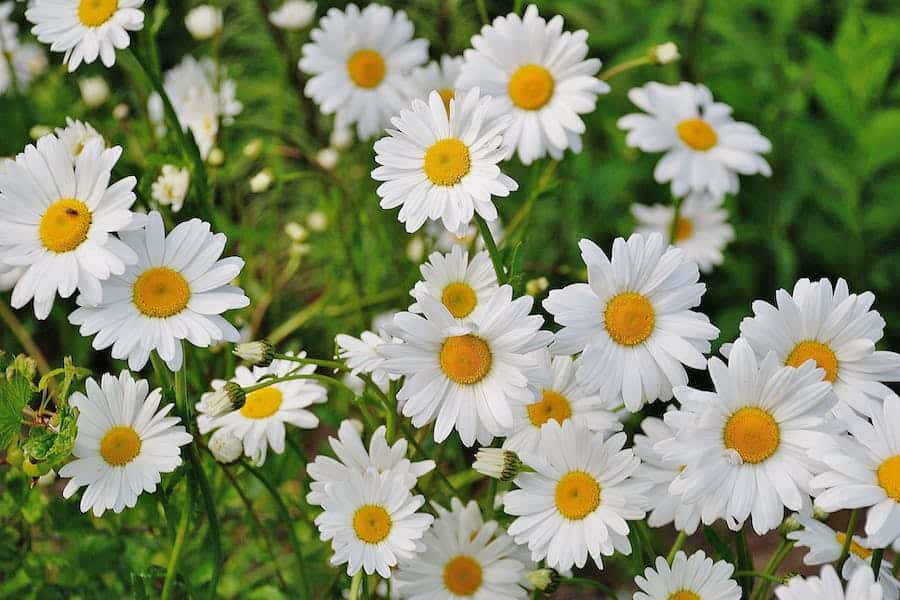Daisies, with their iconic white petals and sunny yellow centers, have captured the hearts of many around the world. These charming flowers symbolize innocence, purity, and new beginnings and have woven their way into countless poems, stories, and even childhood memories. Who hasn’t sat in a sun-drenched meadow plucking daisy petals while reciting, “He loves me, he loves me not”? But amidst the romanticism and symbolism, a practical question arises: how many petals does a daisy actually have? This seemingly simple inquiry takes us on a journey deep into the world of botany, genetics, and nature’s meticulous artistry. The petal count of a daisy is not just a random occurrence; it’s a testament to the intricate design and patterns found in the natural world. In this blog post, we’ll delve into the fascinating world of daisy petals, unearthing the science, the variations, and the reasons behind their specific number. Whether you’re a flower enthusiast, a curious mind, or someone simply appreciating the beauty around you, join us as we explore the delightful enigma that is the daisy.
How Many Petals Does A Daisy Have?
A typical common daisy (Bellis perennis) has around 21 to 34 petals. However, it’s important to note that daisies come in various species, and some might have different petal counts due to genetic variations, environmental factors, or cultivation practices. But for the classic white daisy with a yellow center that most people are familiar with, you can usually expect somewhere in the range of 21 to 34 petals. Always fun to count and see for yourself the next time you come across one!
The Science Behind Petal Count
Nature, in all its exuberant forms, often hides its secrets in plain sight. One such enigma that has beguiled both botanists and mathematicians alike is the number of petals on a flower. A seemingly arbitrary trait, the petal count of many flowers reveals an intricate dance of science and mathematics.
To understand the science behind petal count, it’s crucial to delve into two aspects: genetics and evolutionary advantages. Every flower species has a genetic code that largely predetermines its characteristics, from its color to its petal count. Through the process of natural selection, certain traits become dominant because they offer a competitive advantage, either by attracting pollinators more effectively or adapting better to environmental conditions.
However, it’s not just biology that governs the petal counts; mathematics plays a surprising role, most notably through the Fibonacci sequence. This sequence (0, 1, 1, 2, 3, 5, 8, 13, …) is such that each number is the sum of the two preceding ones. Why does this matter for flowers? Astonishingly, many plants exhibit petal counts that align with the Fibonacci sequence. For instance, lilies often have 3 petals, while buttercups have 5. The captivating spirals of a sunflower, the arrangement of a pinecone, and the petals of a daisy all often fall in line with this mathematical pattern.
The Fibonacci sequence isn’t just a numerical oddity. It reflects an optimal arrangement. For instance, petals or leaves arranged in these numbers often allow for the most efficient utilization of space, ensuring maximum sunlight exposure or optimal rainwater collection. Such patterns can promote healthier growth and better reproductive success.
The evolutionary implications are profound. Flowers with a specific petal count might be more attractive to pollinators. The symmetry and arrangement might make it easier for bees, butterflies, or birds to access nectar, ensuring that, in the process, these pollinators facilitate the transfer of pollen. Over time, as certain flowers benefit from more successful pollination due to their petal count, the trait becomes dominant in the population.
However, the natural world is full of exceptions and variations. Human intervention, particularly in the realm of horticulture, has led to flowers that defy their wild counterparts in petal numbers. By selecting and breeding for particular aesthetic qualities, humans have introduced flowers with “double blooms,” or increased petal counts, such as the lush, multi-petaled roses favored in many gardens.
Environmental factors, too, play a role. Just as drought or nutrient-rich soil can influence a plant’s height or leaf size, so too can it impact its petal count. Stressors or favorable conditions might lead to more or fewer petals as the plant adapts to its surroundings.
Methods For Counting Petals
The counting of petals on a flower might seem a straightforward endeavor at first glance. However, as with many things in the realm of botanical studies, there’s a method to the seeming madness. Whether you’re an enthusiast aiming for the accuracy or a researcher seeking systematic results, understanding the right methods for counting petals is crucial. Let’s delve into the meticulous techniques and considerations behind this seemingly simple task.
Preparation And Handling:
Before counting, it’s vital to handle the flower gently to ensure no petals are inadvertently damaged or detached. Using tweezers or soft-tipped forceps can help in delicately manipulating the flower, especially if it’s small or fragile.
Establishing A Baseline:
Start by observing the flower from a distance to get an initial estimate. Some flowers have a clear and distinct layering of petals, making them easier to count. For instance, roses have concentric circles of petals, while daisies often display a single layer.
Counting Outer To Inner:
For flowers with layered petals, begin counting from the outermost layer and work your way inward. This systematic approach ensures that each petal is accounted for and none are overlooked.
Using Magnification For Smaller Flowers:
In the case of tiny flowers, a magnifying glass or a stereo microscope can be instrumental. Under magnification, not only does counting become more manageable, but you can also appreciate the intricate details and patterns of the petals.
Accounting For Overlaps:
Petals often overlap, especially in buds or densely petaled flowers. Gently using the tweezers to tease apart overlapping petals can provide a clearer view. Remember, the key is to be gentle to avoid tearing or damaging the petals.
Noting Irregularities:
It’s not uncommon to find flowers with missing or underdeveloped petals. While counting, it’s essential to make a note of these irregularities, especially if you’re documenting results for research. These anomalies can offer insights into environmental stresses or genetic variations within a plant population.
Digital Assistance:
With advancements in technology, digital methods can also assist in petal counting. Taking a clear, high-resolution photograph of the flower and enlarging it on a screen can make counting easier, especially for complex flowers. Some software can even help highlight edges, making each petal stand out distinctly.
Repeated Counts For Accuracy:
As with any counting task, human error is always a possibility. It’s a good practice to count the petals more than once to ensure accuracy. If the numbers differ, a third or even fourth count might be necessary.
Documenting And Labeling:
If you’re counting petals on multiple flowers or different species, proper documentation is vital. Label each flower or photograph with its species name, location (if relevant), and petal count. This systematic approach is especially crucial for research or comparative studies.
Contextual Understanding:
While the act of counting petals is primarily numerical, understanding the context can provide deeper insights. For instance, certain flowers might have evolved a specific petal number to attract particular pollinators. Others might have cultural or historical significance tied to their petal count.
Practical Implications Of Knowing Petal Counts
At first glance, knowing the petal count of a flower may appear to be merely an exercise in botanical minutiae. However, understanding petal numbers extends beyond simple observation and can have several practical implications in diverse fields.
- Botanical Identification: One of the primary uses of petal counts is in plant identification. Different species, even within the same family, can have varying petal numbers. Knowing the petal count can be a critical factor in distinguishing between closely related species. For botanists and horticulturists, such specificity can aid in accurate classification and study.
- Breeding And Cultivation: For plant breeders, understanding the typical petal count of a species is crucial. Variations from the norm can indicate hybridization or genetic mutations. Such variations might be deliberately cultivated to produce ornamental varieties with double or multiple petals, adding aesthetic value and fetching higher prices in the market.
- Ecological And Environmental Insights: Consistent deviations from typical petal counts in a natural population could be indicators of environmental stresses or changes. Reduced petal numbers might result from factors such as nutrient deficiencies, pollutants, or unfavorable weather conditions. Observing and noting these deviations can provide researchers with early warnings about ecosystem health.
- Cultural And Historical Context: In many cultures, flowers and their petal counts have symbolic meanings. For example, the eight-petaled lotus in Buddhism symbolizes cosmic harmony, while a five-petaled flower can represent the five elements in various traditions. Understanding petal significance can provide insights into cultural practices, artworks, and historical rituals.
- Educational Tools: For educators, flowers can be a hands-on tool for teaching various subjects. Petal counts can be used to introduce young learners to basic mathematics, patterns, and the Fibonacci sequence. It offers an interdisciplinary approach, blending botany with math and art.
- Art And Design: Artists and designers can draw inspiration from the natural symmetry and patterns observed in petal counts. Such patterns can be replicated or abstracted in designs, artworks, and architectural concepts, underscoring the idea that nature often holds the blueprint for aesthetic appeal and balance.
Conclusion
The daisy, with its delicate white petals encircling a vibrant yellow core, isn’t just a testament to nature’s aesthetic charm but also a lesson in botanical mathematics. While most common daisies boast petal counts aligning with the Fibonacci sequence, this isn’t merely a coincidence but rather a glimpse into nature’s intricate design principles. Whether you’re a budding botanist, a math enthusiast, or simply someone who stops to admire the flowers, the daisy prompts us to seek deeper meanings in the world around us. So, the next time you encounter this unassuming bloom, remember that it holds secrets that are as profound as they are beautiful.
FAQ’s
What Makes A Daisy Special?
The daisy is a unique flower due to its simplicity, beauty, and widespread recognition. Its iconic white petals surrounding a yellow core create a striking contrast, making it easily identifiable. Botanically, what appears as a single flower is actually a composite of numerous tiny flowers, with the white “petals” being individual ray flowers and the yellow center comprising many tiny disk flowers. This composite structure, coupled with its frequent alignment to the Fibonacci sequence in petal counts, lends the daisy its special place in both nature and culture.
What Does A Daisy Symbolize In Love?
In the realm of love, the daisy often symbolizes pure, innocent, and enduring love. Its delicate appearance and simple beauty evoke feelings of youthful love and romantic nostalgia. Historically, daisies have been used in “he loves me, he loves me not” games, where each petal is plucked while alternating between the phrases, aiming to determine a lover’s interest based on the last petal plucked. Thus, in the context of romance, the daisy stands as a symbol of true and innocent affection.
What Does The Bible Say About Daisies?
The Bible does not specifically mention daisies by name. However, flowers and fields in general are frequently referenced in the Bible, often symbolizing the transient nature of life or the splendor provided by God. One famous verse, Matthew 6:28-30, speaks of considering the lilies of the field and how they neither toil nor spin, yet are clothed in glory, suggesting that God will care for all, even more than these beautiful flowers. While this verse refers to lilies, the sentiment can be extended to other flowers like daisies, emphasizing the care and attention of the Divine to even the simplest and smallest details of creation.



















Leave a Reply